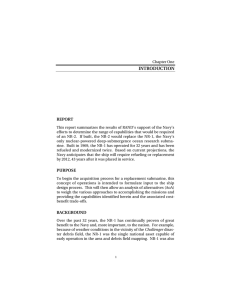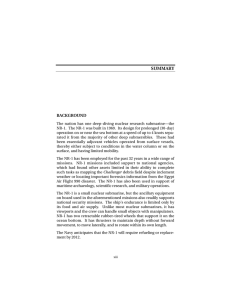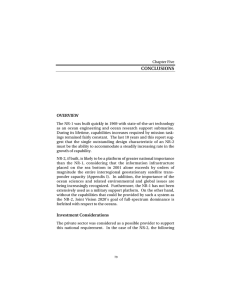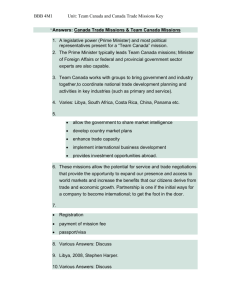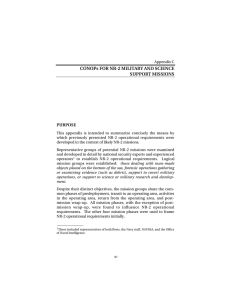MILITARY MILITARY MISSIONS
advertisement
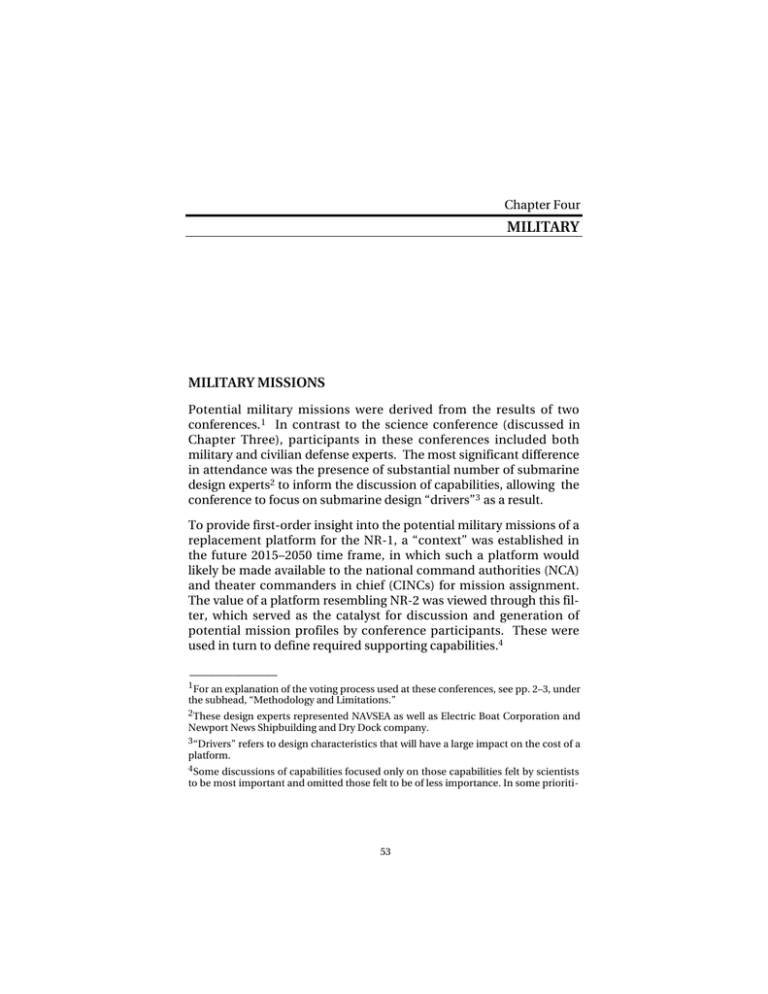
Chapter Four MILITARY MILITARY MISSIONS Potential military missions were derived from the results of two conferences. 1 In contrast to the science conference (discussed in Chapter Three), participants in these conferences included both military and civilian defense experts. The most significant difference in attendance was the presence of substantial number of submarine design experts2 to inform the discussion of capabilities, allowing the conference to focus on submarine design “drivers”3 as a result. To provide first-order insight into the potential military missions of a replacement platform for the NR-1, a “context” was established in the future 2015–2050 time frame, in which such a platform would likely be made available to the national command authorities (NCA) and theater commanders in chief (CINCs) for mission assignment. The value of a platform resembling NR-2 was viewed through this filter, which served as the catalyst for discussion and generation of potential mission profiles by conference participants. These were used in turn to define required supporting capabilities.4 ______________ 1 For an explanation of the voting process used at these conferences, see pp. 2–3, under the subhead, “Methodology and Limitations.” 2 These design experts represented NAVSEA as well as Electric Boat Corporation and Newport News Shipbuilding and Dry Dock company. 3 “Drivers” refers to design characteristics that will have a large impact on the cost of a platform. 4 Some discussions of capabilities focused only on those capabilities felt by scientists to be most important and omitted those felt to be of less importance. In some prioriti- 53 54 A Concept of Operations for a New Deep-Diving Submarine After completion of the first conference and review of results generated by that conference, a second conference was held to refine and review the NR-2 military missions from the initial military conference (see section on “Military Mission Refinement” below). Results Summary The military expert group at the first conference developed the following 11 mission categories along with mission profiles: 5 • Systems Manipulation/Implantation/Control • Recovering Objects • Disabling/Removing Objects • Forensics/Investigation • Area Sanitization/Investigation • Intelligence Surveillance and Reconnaissance (ISR) • Support to Military Research and Development • Gatekeeper • Deep Diver/Special Operations Forces (SOF) Support • Search and Rescue • Undersea Logistics (Navy After Next concept). During the second conference, a listing of candidate core NR-2 missions was generated by expanding, prioritizing, grouping, and down selecting from the mission list generated in the first conference. The process yielded the prioritized list of candidates for NR-2 core6 military missions: 1. Selected Covert Operations _____________________________________________________________ zations, new capabilities were occasionally added in an exploratory effort but were then found to have negligible impact on expected cost. 5 Details for profiles of all proposed military missions listed below are in Appendix E. 6 Core missions are defined as those missions that would be assigned by the com- mander/NCA preferentially to the NR-2 above all other platforms. Military 55 2. Protection of National Assets on the Seabed 3. Intelligence Preparation of the Battlespace (IPB) 4. Forensics/Investigation 5. Expanded ISR 6. Offensive Information Operations 7. Defensive Information Operations SUPPORT CONCEPTS NR-1, the predecessor to NR-2, has not been heavily involved in military operations (individually or with support). Examining potential future military operations (2015–2050), the study considered three different support concepts (these are illustrated in Appendix G): • Fully autonomous operation. In this mode the NR-2 would be designed for fully autonomous operation, as is any SSN. Among other considerations this would have the inherent implications on design for redundancy and speed-endurance in area-ofinterest (AOI) trade-offs, which were not necessary in NR-1. • Operation in consort with an SSN. This concept would provide SSN transport/tow to an AOI and escort/protection within an AOI as desired. The principal purpose of the SSN would be to minimize NR-2 time lost in transit and maximize mission time in AOI. Naturally, logistics and communication support is not as feasible in this mode of support. • Operation in consort with a surface support vessel. This method of operation has proven particularly valuable in NR-1’s operation on science and forensics/investigation missions (where sea conditions were accommodating for surface support). Surface support vessels can provide extensive logistics support to science missions both in crew relief and mission equipment support and enable transfer and offload of objects from NR-1. In the past, the surface vessel also provided tow and communications support when required/operationally desirable. Although the concept of a dedicated surface ship “carry” to an AOI was discussed, it was not seriously pursued because of the current 56 A Concept of Operations for a New Deep-Diving Submarine limitations on overall Navy force structure. As with the NR-1, a single design can use all of these support concepts. In evaluating the range of potential military missions over the life of the ship, 80 percent of the participants considered the fully autonomous concept of operation as the most appropriate as shown in Figure 4.1. None considered the surface ship support concept as appropriate if the NR-2 were to become more militarily mission assigned than the NR-1 was historically. Some submariners considered an SSN escort preferable. This generally reflected the view that an SSN is capable of providing the required “transit” assistance to the NR-2. Within these three CONOPs two other military design considerations were examined: quieting (magnetic and acoustic) and endurance. Quieting. As seen in Figures 4.2 and 4.3, to reasonably bound quieting capability, three levels of acoustic and magnetic quieting were considered by participants: NR-1 level (no quieting), SSN-688-class RANDMR1395-4.1 ! " Figure 4.1—Support CONOP Preferences Military 57 level, which was used to represent 1970s–1980s’ technology, and state of the art, used to represent the quieting available on the most advanced U.S. submarines. Best quieting was desired for the fully autonomous and the surface ship escort concepts. These choices are logical. Least quieting was acceptable in the case of SSN escort. Again, this was a logical choice. In the former case, NR-2 vulnerability in the area of interest will be a function of its own signature. In the latter case, participants’ concern focused on the potential for adversary alert by the escort surface ship. In terms of the sonar equation, this effectively raises the noise recognition differential through alert to the possibility of an intruder—hence the greatest desire for the state-of-the-art acoustic quieting. A similar pattern is noted for magnetic quieting. At the recommendation of NAVSEA 05 and the other ship designers, the aforementioned capabilities were prioritized across the mission areas that clearly broke out as the top three future military mission categories for NR-2 (namely, recovering objects, system manipulation, and removing or disabling objects). RANDMR1395-4.2 1.0 0.9 State-of-the-art SSN-688 NR-1 Rank sum score 0.8 0.7 0.6 0.5 0.4 0.3 0.2 0.1 0 Fully autonomous SSN escort Surface ship escort Support CONOP Figure 4.2—Acoustic Quieting Preferences by Support CONOP 58 A Concept of Operations for a New Deep-Diving Submarine RANDMR1395-4.3 1.0 0.9 State-of-the-art SSN-688 NR-1 Rank sum score 0.8 0.7 0.6 0.5 0.4 0.3 0.2 0.1 0 Fully autonomous SSN escort Surface ship escort Support CONOP Figure 4.3—Magnetic Quieting Preferences by Support CONOP Figure 4.6 reflects the prioritization of these capabilities across the higher-priority mission areas. Of note, the capabilities are uniformly weighted across all mission areas. Also of importance is the isolation of the bottom four capabilities (under-ice capability, redundancy, burst speed, and shock hardening). MILITARY MISSION GENERATION Before determining required capabilities, relative mission importance was assessed from four perspectives (Figure 4.4). All conference participants participated in these evaluations. Importance was first evaluated from two perspectives: future mission importance and future mission likelihood. The product of these was considered to be the measure of expected value. Participants evaluated each mission based on the relative likelihood of occurrence in the period of interest. Next, the missions were compared on the basis of importance—that is, if this mission were to be assigned by the NCA Military 59 RANDMR1395-4.4 1.0 0.9 Overall Operators NCA perspective Likelihood and import Mission rankings 0.8 0.7 0.6 0.5 0.4 0.3 0.2 0.1 em st D Sy R ec ov er in g ob s je m ct is i s ab m an lin pla ipu nt la g/ /c tio re m on n ov t / Fo in rol g re ob ns je ic ct s s in ve s tig Ar at ea io s n in ani ve tiz st at ig io at n/ io n M ilit ar y IS R R &D su pp or D t G ee a te p ke di ve ep r/S er O F Se su pp ar ch or t an U d nd re s er cu wa e te rl og is tic s 0 Military mission Figure 4.4—Mission Rankings or military commander, how damaging would it be if the mission were not executed correctly. The combination of these two evaluations is reflected by the black bars in Figure 4.4. The striped bar “NCA perspective” reflects the participants’ evaluation of the relative importance that the NCA would place on the mission capabilities attached to the NR-2. The “Operators” bar reflects the view that those participants with extensive operational military experience had of the priority of NR-2’s mission capabilities. The “Overall” bar reflects the overall ranking of NR-2 missions—that is, across the future landscape, the priorities of missions likely to be assigned to the NR-2 during its lifetime. In effect, this reflects participants’ views of the mission’s priorities the sponsor should establish for NR-2. Broad consistency in rankings is clear in Figure 4.4. The most noteworthy result of this ranking process is that regardless of which of the 60 A Concept of Operations for a New Deep-Diving Submarine four ways the survey was posed or to whom it was posed, six missions (recovering objects, systems manipulation, disabling objects, forensics investigation, area sanitization, and ISR) were always ranked above the other missions. Viewed from a different perspective, the missions of military R&D support, gatekeeper, deep diver/SOF support, search and rescue, and underwater logistics were always ranked below the other missions. The result of this schism in the mission set is a “break” in the ranking system between the ISR and R&D support. Also of note, the top missions were directly related to the NR-2’s projected ability to operate on or near the bottom; the lower-ranked missions did not mandate that capability. The consistency in Figure 4.4 shows that a rank sum can be applied to the 11 missions to achieve an overall ranking, shown in Figure 4.5, which indicates the break between ISR and military R&D support. RANDMR1395-4.5 4.0 Overall Operators NCA perspective Likelihood and import 3.5 Rank sum 3.0 2.5 2.0 1.5 1.0 0.5 R ec ov er Sy in st g em ob s je D m ct is s ab im an p lin la ipu nt la g/ / re t m con ion ov t / Fo in rol g re ob ns je ic ct s s in ve s tig Ar at ea io s n in ani ve tiz st at ig io at n/ io n M ilit ar y IS R R &D su pp or D t G ee at p e ke di ve ep r/S er O F Se su pp ar ch or t an U d nd re sc er wa ue te rl og is tic s 0 Military mission Figure 4.5—Rank Sum Mission Ranking Military 61 The missions of recovering objects and systems manipulation/implantation/control are functionally tied for higher rank. Underwater logistics was generally ranked last and in rank sum is last. This was likely due to three main factors. First, the inability to articulate the mission well because, as a Navy After Next (NAN) concept, it remained embryonic and ill-defined both in tangible operational requirement and capability—hence, mission—during the conference. Second, little in the title commended itself to the NR-2 as a deep submersible as an assigned vehicle for execution. Third, implicit in the mission of underwater logistics were requirements for speed and size orthogonal to other mission capabilities for NR-2. At the request of NAVSEA, the three highest-priority missions were used to evaluate the following NR-2 design-driving capabilities:7 • Burst speed • Transit speed • Ingress/on-station/egress speed • Test depth • Acoustic quieting • Magnetic quieting • Ability to operate on or near the bottom • Ability to reposition on or near the bottom • Under-ice capability • Ocean interface • Offensive weapons • Shock hardening • Endurance. Along with the above design-driving capabilities, three ancillary capabilities (payload, flexibility/adaptability, and redundancy) were ______________ 7 Design-drivers were developed through discussions with ship designers. Definitions of these drivers can be found in Appendix D. 62 A Concept of Operations for a New Deep-Diving Submarine also selected for examination in the context of the three highestpriority missions. Their relative ranking can be seen in Figure 4.6. Because no objective and universal weighting scheme was readily apparent in this study, a uniform weighting scheme was employed with capabilities to get a first-order insight into relative capability. As noted above (in footnote 4), some discussions of capabilities focused only on those capabilities felt by scientists to be the most important and omitted those thought to be of lower importance. In some prioritizations, new capabilities were occasionally added in an exploratory effort but were then found to have negligible impact. The participants and designers discussed the concept of modular design at length. Rather than listing modularity as an ancillary capability or a full capability, designers maintained that future flexibility or adaptability would be achieved in the most cost-effective manner and in fact, modularity would be a design result as appropriate based on these overarching considerations. RANDMR1395-4.6 .14 .12 .08 .06 .04 .02 Figure 4.6—Capabilities Ranking de ni ha r Sh oc k rs Bu ng d pe e e ts er ic y NR-2 capability U nd an c R ed u nd D ep th 0 ad Fle ap xib ta ilit bi y/ lit y Pa Ac yl oa ou d st ic qu i et O in ce g an in te rfa ce Tr an si ts pe ed En du ra nc e Relative score .10 Military 63 MISSION RANKING CAPABILITY IMPLICATIONS The preceding paragraphs discussed the methods used for obtaining the required mission sets for a replacement platform for the NR-1 and the methods used to prioritize those missions and thereby reflect the weight or impact that the need to accomplish those missions should have on the capabilities incorporated into the NR-2. Looking back more closely at Figure 4.4, however, allows missions to be segregated into two broad categories, those of likely high future import from the NR-2 (for our purposes those missions always grouped as the top five missions) and those of low likely future import from the NR-2 (for our purposes those missions always grouped as the bottom five missions). Table 4.1 summarizes values derived for design-driving capabilities required for the identified military missions. From the viewpoint of Table 4.1 Required NR-2 Capabilities Capability Flexibility/adaptability Payload Acoustic quieting Large ocean interface Transit speed Endurance Depth Redundancy Under ice Burst speed Shock hardening Value Highest priority Second highest priority SSN-688 to state of the art8 Essential 15–20 knots 30–45 days 500–1,000 meters with adjuvant vehicle 1,000 meters without adjuvant vehicle Low priority Not required 15–20 knots Lowest priority ______________ 8 Figures 4.2 and 4.3 suggest that state-of-the-art quieting was distinctly preferred but was not clearly regarded to be required in discussions with cost considerations ignored. In light of the upcoming AoA, ruling out the less-expensive SSN-688 quieting would seem premature. 64 A Concept of Operations for a New Deep-Diving Submarine capabilities to be included on the NR-2, it is noteworthy that one capability set will satisfy all the needs to accomplish the high-import missions. Said differently, this method of mission ranking allowed visibility into like groupings of mission sets, hence into the drivers of like capability requirements and like concepts of operation. CONCEPTS OF OPERATION Concepts of operation for execution of these mission profiles are included in Appendix C. MILITARY MISSION REFINEMENT A second military conference was held to review and refine the NR-2 military missions from the initial military conference with a group of submarine operations experts over a greater range of potential submarine operations in support of the NCA, to prioritize these missions in the context of 2015–2050, and to determine NR-2 capability thresholds9 and objectives 10 for core missions (again emphasizing cost-driving capabilities) and further to prioritize these capabilities across all missions. The new set of NR-2 military missions accommodated all illustrative mission objectives from the first symposium. For example, the mission of recovering sensitive objects from crash/wreck sites (originally included in the manipulate/recover objects military mission category was now accommodated under forensics investigation). To further prioritize NR-2 core military missions, the proposed missions were prioritized again by expected frequency of occurrence in the future and by the relative impact of mission failure on national security (should they be conducted). The product of these two mea______________ 9 That minimum acceptable value that, in the user’s judgment, is necessary to satisfy the need. If threshold values are not achieved, program performance is seriously degraded, the program may be too costly, or the program may no longer be timely (DoD, 1996). 10 The value desired by the user that the program manager (PM) is attempting to obtain. The objective value would represent an operationally meaningful, time critical, and cost-effective increment above the threshold for each program parameter (DoD, 1996). Military 65 sures provides an overall evaluation of mission importance. Highest scores go to missions expected to occur relatively often and to be of relatively high importance, should they fail in execution, to national security. The output provides a weighting to be assigned to capabilities (supporting missions) being designed into the NR-2 in any costbenefit trade-off process. Conference participants were in strong agreement as to expected frequency of mission occurrence (Figure 4.7). The protection of national assets on the seabed mission, for example, was expected to occur most frequently or second most frequently by a clear majority of participants. At the other extreme, a clear majority ranked the covert operations mission last by expected frequency of occurrence. As a result, capabilities associated with the successful accomplishment of the protection of national assets on the seabed mission RANDMR1395-4.7 Frequency rank sum 9 8 7 6 5 Covert 4 Mission 3 2 1 0 1 2 3 4 Rank 5 6 Cove r t ope ration s Defen sive in fo rmati Expa o n ope nded ration ISR s Offen sive in forma tion o IPB perati ons Foren sics/i nvesti gatio Prote n ction of na tiona l asse 7 ts on the s eabe d Figure 4.7—Mission Frequency Rankings 66 A Concept of Operations for a New Deep-Diving Submarine (essentially a defensive information operations mission) would logically be assigned a high priority in the design and trade study process. Conversely, those capabilities associated with covert operations when destruction of enemy assets was the objective (e.g., shock hardening) would receive lower priority. Less uniformity is seen in ranking missions by their criticality to national security (Figure 4.8). The results shown in the previous two figures are shown in rank sum form in Figures 4.9 and 4.10. Combined, or overall, mission priorities are shown in Figure 4.11. These were generated as rank sums of priority assignments. Core NR-2 military mission priorities in the 2015–2050 time frame stem from the NR-2 capability set differentiating it from other platforms. These are as follows: RANDMR1395-4.8 Criticality sum 6 5 4 Defensive Info Ops 3 Mission 2 Foren s Expa 1 nded IPB Defen 0 1 2 forma sive in Prote ction 4 Rank 5 Cove r t ope 6 7 tion o forma of na s Figure 4.8—Mission Criticality Ranking perati tion o tiona ration ation ISR sive in Offen 3 ics/in vestig ons l asse perati ts on ons the s eabe d Military 67 RANDMR1395-4.9 Relative frequency of occurrence 1.0 0.9 0.8 0.7 0.6 0.5 0.4 0.3 0.2 0.1 0 Protection Forensics of national investigation assets on the seabed IPB Offensive information operations Expanded ISR Defensive information operations Covert operations Military mission Figure 4.9—NR-2 Military Mission Expected Frequency of Occurrence RANDMR1395-4.10 1.0 0.9 Relative criticality 0.8 0.7 0.6 0.5 0.4 0.3 0.2 0.1 0 Covert operations Protection Offensive Defensive of national information information assets on operations operations the seabed IPB Expanded Forensics ISR investigation Military mission Figure 4.10—NR-2 Military Missions Expected Relative Criticality 68 A Concept of Operations for a New Deep-Diving Submarine RANDMR1395-4.11 1.0 0.9 Mission priority 0.8 0.7 0.6 0.5 0.4 0.3 0.2 0.1 0 Protection Offensive of national information assets on operations the seabed IPB Forensics Expanded investigation ISR Defensive Covert information operations operations Military mission Figure 4.11—NR-2 Military Mission Priorities • Ability to operate on the seabed. • An ocean interface with the (implicit) ability to operate a stateof-the-art ROV that would allow it to extend its effective operating depth for object deployment, manipulation, or recovery below the test depth of the submarine. The above mission scores strongly favor the protection of national assets mission, which was rated first in frequency of occurrence. There were two broad reasons for this ranking. First, as noted in Appendix I, in the past six years we have witnessed an exponential increase in international communications capacity stemming almost entirely from fiber optic cables laid on the seabed. Fiber optic capacity on the seabed now exceeds space capacity (by several orders of magnitude—space systems cannot be substituted for fiber optic systems on the seabed). Second, in the opinion of the participants, if built, the NR-2 would be the only dedicated national asset capable of both providing protection for the national information infrastructure on the seabed and deterring efforts to damage that infrastructure. This mission on a broad level is a national defensive Military 69 information warfare mission. Participants also recognized that it will only increase in value in the future, and in consideration of the threat, the threat against which it is conducted will likely also proliferate beyond the current targeting of military assets and improve in proficiency in the 2015–2050 time frame.11 The covert operations mission is scored last of these seven missions because of the expectation that the need to conduct it would be rare. The low score of the covert operations mission, combined with its distinctive mission profile, indicates that the consensus of those operational experts present was that NR-2’s value would be in its design to operate and gather information and intelligence from the sea bottom, not in potential employment as a combatant. This is also consistent with three broader views noted by participants: • The leverage of the NR-2 would be in completing the national “full spectrum” IPB capability. • NR-2’s potential as the transition continues to a cyberwar environment.12 • The availability to the NCA of many other (SOF) assets to accomplish “direct action” combat missions. DESIGN-DRIVING CAPABILITIES The design-driving capabilities derived in the first NR-2 military CONOPs conference carried over into the second conference. Again, they were: • Burst speed • Transit speed • Ingress/on-station/egress speed • Test depth ______________ 11Participants carefully reviewed classified and unclassified assessments of existing and projected threats regarding this issue. 12 Cyberwar is defined as conducting, or preparing to conduct, military operations according to information-related principles (Arquilla and Ronfeldt, 1997, p. 30). 70 A Concept of Operations for a New Deep-Diving Submarine • Acoustic quieting • Magnetic quieting • Ability to operate on or near the bottom • Ability to reposition on or near the bottom • Under-ice capability • Offensive weapons • Ocean interface • Shock hardening • Endurance. (The scientific and military values for each of these design-driving capabilities is discussed in Chapter Five.) Current operational submariners and former OICs of NR-1 provided inputs on capability objectives and thresholds for the NR-2 across the core mission areas addressed at the second military conference. Their inputs are presented first by thresholds, then by objectives using natural groupings. Speed Thresholds Three speed regimes were prioritized by capability importance to operators. In priority order, these were transit speed, ingress/onstation/egress speed, and burst speed. Speed thresholds for NR-2 are shown in Figure 4.12 (with ingress/on-station/egress speed shown as “Speed in AOI” in the interest of brevity). Transit speed in the range of 14 to 18 knots was preferred for two reasons: to allow prompt response to tasking and to maximize time onstation in the case of fully autonomous operations. Speed in AOI of 8 to 10 knots was preferred, the better to allow adequate search speed with the presumptive sensor suite. Burst speeds of 15 to 20 knots were preferred. Military RANDMR1395-4.12 ! 71 Figure 4.12—NR-2 Speed Thresholds All speed preferences were consistent with a defensive operational philosophy exploiting low signatures and minimizing time on station. In essence, the NR-2 operational philosophy, if employed in covert military missions, would be to be responsive to tasking, ingress the area of interest quickly, complete the mission promptly, minimize time on station, leave no evidence of the mission, and exit quickly undetected (“get in, get out, leave nothing behind”). Depth Figure 4.13 depicts preferred depth thresholds with and without an ROV/AUV.13 A clear preference for a 1,000-meter test depth is evident. Such a depth would allow NR-2 to operate on or near the bottom over most continental shelves. Because one perceived advantage of the ROV/AUV has been its ability to go beneath a given level, ______________ 13As noted earlier, depictions of world hypsometry can be found in Appendix F. 72 A Concept of Operations for a New Deep-Diving Submarine RANDMR1395-4.13 !"# $ !"# Figure 4.13—NR-2 Depth Thresholds it is striking that preferred depth threshold was the same with and without an ROV/AUV. This is likely due to the current state of the art. Current ROV/AUV limitations with regard to search capability and long-term navigational accuracy seemed to hamper military missions. It was noted that NR-2 operation on the bottom protects against threat weapons and that putting an ROV/AUV on the bottom offers no such protection. Skepticism also arose that ROVs/AUVs would have adequate bottom search/registration capabilities. Signature Acoustic and magnetic signatures were specified as state of the art. Acoustic quieting was desired for reducing encounter rates. Magnetic quieting would protect against mines and potential tripwires. Bottom Operations The need to operate on or near the bottom was unquestioned. Military 73 Under-Ice Capability No need was seen for NR-2 to have the ability to operate under ice. This was consistent with the first NR-2 military mission conference findings, where under-ice capability was ordered last in desirability. Offensive Weapons No need was seen for providing NR-2 with offensive weapons. This was also consistent with the first NR-2 military CONOPs symposium. Ocean Interface The participants saw a clear need for an ocean interface. An ocean interface was a high priority in the first NR-2 military CONOPs symposium. Shock Hardening The participants were divided over the need for shock hardening; some agreed strongly with such a need but others were neutral on the need or felt that shock hardening was unnecessary. Overall, the participants leaned toward shock hardening. Response in the first NR-2 military CONOPs symposium was also divided but leaned away from shock hardening. Endurance Strong consensus was seen for 60 days of endurance for NR-2. This was felt to provide adequate time on station after a long transit. Participants in the first NR-2 military mission symposium generally favored a shorter endurance capability—in the range of 30 to 45 days. Speed Objectives NR-2 speed objectives for ingress/on-station/egress and transit speed objectives (Figure 4.14) resemble their corresponding speed thresholds. However, NR-2 burst speed objectives are significantly 74 A Concept of Operations for a New Deep-Diving Submarine RANDMR1395-4.14 ! Figure 4.14—NR-2 Speed Objectives higher than the burst speed thresholds (Figure 4.15). Again, ingress/on-station/egress speeds of about 8 to 12 knots are desired. Transit speeds of 14 to 26 knots are seen. The disparity between NR-2 burst speed thresholds and objectives as viewed by the same operators is consistent with the low priority given to burst speed previously; a large increase in burst speed is required to produce an appreciable boost in mission effectiveness. Depth Objectives NR-2 test depth objectives with and without an ROV/AUV are shown in Figure 4.16. Other than one outlying 6,000-meter test depth, they are similar to NR-2 depth thresholds seen previously. MISSIONS The second military conference confirmed and expanded the mission objective set from the first military conference. The mission Military RANDMR1395-4.15 !" 75 Figure 4.15—NR-2 Burst Speed Thresholds and Objectives RANDMR1395-4.16 .45 .40 With ROV/AUV Without ROV/AUV Fraction of preferences .35 .30 .25 .20 .15 .10 .05 0 200 500 1,000 2,000 Depth (meters) Figure 4.16—NR-2 Depth Objectives 4,000 6,000 76 A Concept of Operations for a New Deep-Diving Submarine niche of the NR-2 was confirmed as missions derivative from the NR2 capability set of bottom operations coupled with manipulation capabilities and the covertness inherent in the submerged platform. Figure 4.17 summarizes the mission priorities established at the conference. CAPABILITIES The ability of the NR-2 to operate on or near the bottom was the most highly valued capability, followed by a large ocean interface. The level of redundancy required of NR-2 exceeded that of NR-1 in order to support projected operations. The least valuable capability was the ability to operate under ice (Figure 4.18). Table 4.2 provides the threshold values for these capabilities. CONCEPTS OF OPERATION Concepts of operation for actual execution of these mission profiles are included in Appendix C. RANDMR1395-4.17 1.0 0.9 Mission priority 0.8 0.7 0.6 0.5 0.4 0.3 0.2 0.1 0 Protection Offensive of national information assets on operations the seabed IPB Forensics Expanded investigation ISR Defensive Covert information operations operations Military mission Figure 4.17—NR-2 Military Mission Priorities Military 77 RANDMR1395-4.18 .30 Relative score .25 .20 .15 .10 .05 0 Operation on/ Large ocean near bottom interface Shock hardening Offensive weapons Under ice Capability Figure 4.18—Design-Driving Capabilities Prioritization Table 4.2 Capability Threshold Values Capability Acoustic quieting Large ocean interface Transit speed Endurance Depth Under ice Burst speed Shock hardening Value SSN-688 to state of the art Essential 14–18 knots 60 days 1,000 meters with adjuvant vehicle 1,000 meters without adjuvant vehicle Not required 16–20 knots Lowest priority
